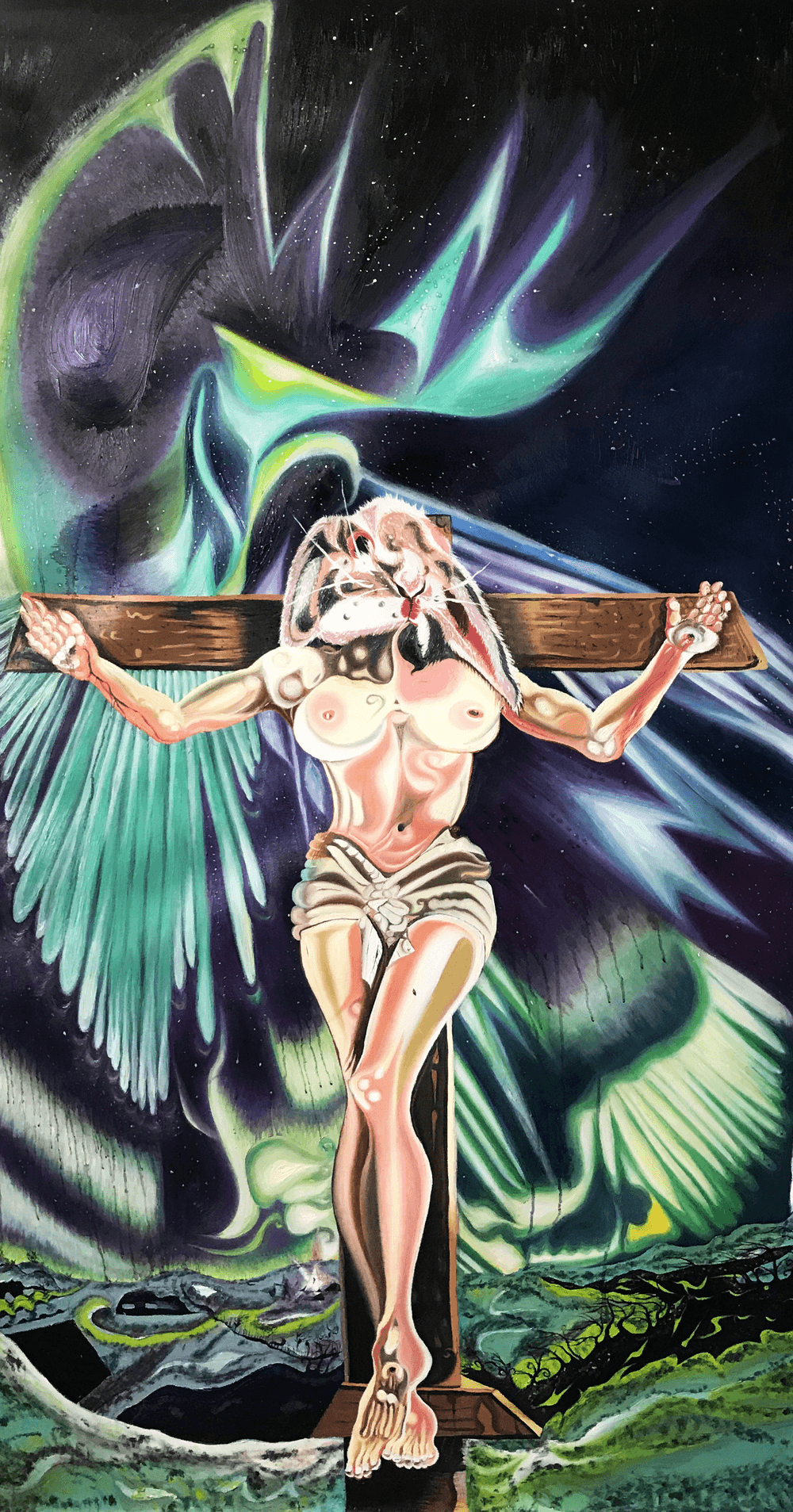

Title: The Epiphany of Wenut II Type: Oil on canvas Size: 170 x 102 cm Created: 2019
3 of 3
Exploring the same themes as "The Epiphany of Wenut I”, this painting presents a white-skinned, more sexualised female body on the cross with a pinkish hare head. Here, Kan takes inspiration from Laura Mulvey’s essay, “Visual Pleasure and Narrative Cinema”. In a nutshell, Mulvey argued, drawing on psychoanalysis, that Hollywood cinema was structured along a threefold gaze (by the audience, the camera and the characters) that looks at women from a male point of view and regards them as mere (sexual) objects. Mulvey divided the traditionally male perspective on women into two categories: the licentious whore/femme fatale and the unsexy good wife. The body portrayed on this canvas denotes and parodies the former category in hyperbolic fashion. In relation to the other "The Epiphany of Wenut I”, the Northern Light colours are much more venomous and intense. As part of the NFT utilities for this triptych, you will have the unique opportunity to get a complimentary consultation from the artist herself about applying for art residencies in Iceland.
This painting is part of an oil painting triptych, completed during the SIM art residency in Reykjavik, Iceland in 2019. The triptych explores the notion of hanging female bodies on the Judeo-Christian symbol of the cross. Rather than being blasphemous towards Christianity, this series pays homage to the unspoken and unwritten suffering of women throughout the course of patriarchal history. Each body depicted in the triptych has a different race, so that women of all colours are represented. This inclusion is partly rooted in Kan’s study of Feminism during her English Literature MA degree at the University of Edinburgh. In the second and third-wave feminist periods, women of colour emerged into the feminist literary space, arguing that feminist movements were essentializing the experiences of women....
3 of 3

- 価格米ドル価格数量有効期限送信元
- 価格米ドル価格数量最低価格差有効期限送信元
Title: The Epiphany of Wenut II Type: Oil on canvas Size: 170 x 102 cm Created: 2019
3 of 3
Exploring the same themes as "The Epiphany of Wenut I”, this painting presents a white-skinned, more sexualised female body on the cross with a pinkish hare head. Here, Kan takes inspiration from Laura Mulvey’s essay, “Visual Pleasure and Narrative Cinema”. In a nutshell, Mulvey argued, drawing on psychoanalysis, that Hollywood cinema was structured along a threefold gaze (by the audience, the camera and the characters) that looks at women from a male point of view and regards them as mere (sexual) objects. Mulvey divided the traditionally male perspective on women into two categories: the licentious whore/femme fatale and the unsexy good wife. The body portrayed on this canvas denotes and parodies the former category in hyperbolic fashion. In relation to the other "The Epiphany of Wenut I”, the Northern Light colours are much more venomous and intense. As part of the NFT utilities for this triptych, you will have the unique opportunity to get a complimentary consultation from the artist herself about applying for art residencies in Iceland.
This painting is part of an oil painting triptych, completed during the SIM art residency in Reykjavik, Iceland in 2019. The triptych explores the notion of hanging female bodies on the Judeo-Christian symbol of the cross. Rather than being blasphemous towards Christianity, this series pays homage to the unspoken and unwritten suffering of women throughout the course of patriarchal history. Each body depicted in the triptych has a different race, so that women of all colours are represented. This inclusion is partly rooted in Kan’s study of Feminism during her English Literature MA degree at the University of Edinburgh. In the second and third-wave feminist periods, women of colour emerged into the feminist literary space, arguing that feminist movements were essentializing the experiences of women....